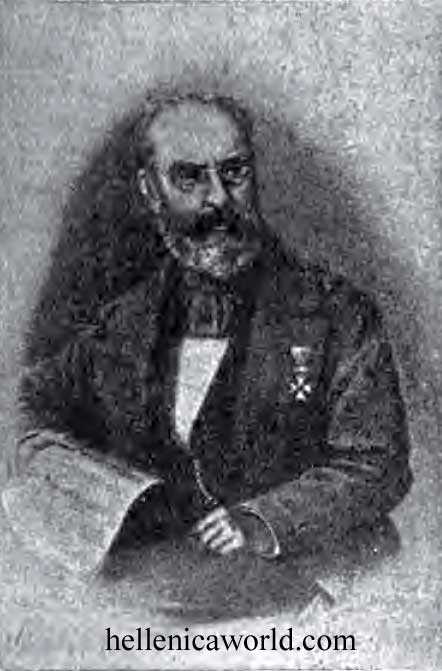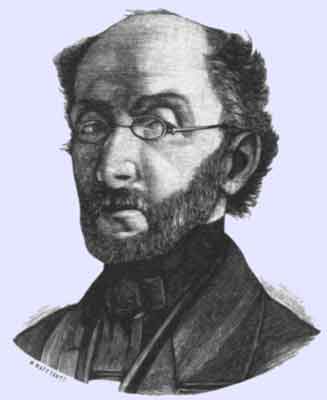.
Nikolaos Chalikiopoulos Mantzaros (Greek: Νικόλαος Χαλικιόπουλος Μάντζαρος, Greek pronunciation: [ɲiˈkola.os xaliˈcʝopulos ˈmant͡saros]; Italian: Niccoló Calichiopoulo Manzaro, 26 October 1795 – 12 April 1872) was an Italian-Greek composer born in Corfu and the major representative of the so-called Ionian School of music (Επτανησιακή Σχολή).[1][2]

Biography
Mantzaros was of noble Italian descent, coming from one of the most important and wealthy Venetian families of the "Libro d'Oro" di Corfu and therefore he never considered himself a "professional composer".[2] Recent research and performances have led to a re-evaluation of Mantzaros as a significant composer and music theorist.[3]

Debut in Corfu
He was taught music in his native city by the brothers Stefano (pianoforte) and Gerolamo Pojago (violin), Stefano Moretti from Ancona (music theory) and cavalliere Barbati, possibly a Neapolitan (music theory and composition).[2] Mantzaros presented his first compositions (three concert or substitute arias and the one-act azione comica Don Crepuscolo) in 1815 in the theatre of San Giacomo of Corfu.
His relationship to Italy
From 1819 onwards he was regularly visiting Italy (Venice, Bologna, Milan, Naples), where, among others, he met the veteran Neapolitan composer Niccolo Antonio Zingarelli.[2] His compositions include incidental music, vocal works in Italian and demotic Greek, sacred music for the Catholic Rite (three masses (1819?, 1825, 1835?), a Te Deum (1830)) and the Orthodox Church (notably, a complete mass based on the septinsular polyphonic traditional chanting (1834)), band music, instrumental music (24 piano sinfonie, some of them also for orchestra) etc. Mantzaros also composed the music for the first concert aria in Greek in 1827, the Aria Greca.
Mantzaros was an important music theorist, contrapuntist and teacher.[2][3] From 1841 and until his death he was the Artistic Director of the Philharmonic Society of Corfu.
The initial pages of an 1820 piano 'Sinfonia' by Nikolaos Halikiopoulos Mantzaros (composer's autograph). It is exhibited in the Music Museum of the Philharmonic Society of Corfu

Solomos and Mantzaros
Greek national anthem
His most popular composition remains the musical setting for the poem of Dionysios Solomos' Ýmnos eis tīn Eleutherían (Hymn to Liberty), which Mantzaros added to Solomos' poem in 1828.[1][2][4] The first and second stanzas were adopted initially in 1864 as the Royal Anthem of Greece and on 28 June 1865 as the Greek national anthem. However, recent research and performances have proved that Mantzaros had broader activities as a significant composer and music theorist, which go beyond the established perception of him as the mere composer of the National Anthem.[3]
Recordings
Mantzaros-Solomos: The Hymn to the Liberty (Lyra, CD0064, 1991)
Music of the Ionian School. N.Mantzaros, N.Lambelet, P.Carrer (Motivo, NM1049, 1996). The 'Nikolaos Mantzaros Chamber Music Ensemble' performing arrangements from piano Sinfonias by Mantzaros.
Nikolaos Halikiopoulos Mantzaros (1795-1872): Early Works for voice and orchestra (1815-1827) (Ionian University / Music Department, IUP005, 2005)
Don Crepuscolo performed by Christophoros Stamboglis, George Petrou and Armonia Atenea (Athens Camerata) in the CD Georg Friedrich Haendel, Alessando Severo / Niccolo Manzaro, Don Crepuscolo (MDG, LC06768, 2011)
Niccolo Calichiopulo Manzaro - Fedele Fenaroli, Partimenti for String Instruments performed by Ionian String Quartet (Irida Classics 009, 2011)
See also
Andonios Liveralis
Ionian School
References
Frucht, Richard C. (2004). Eastern Europe: an introduction to the people, lands, and culture. Vol. 2, Volume 2. Balkan Peninsula: ABC-CLIO. p. 870. ISBN 978-1576078006.
Zervanos, Lydía (2015). Singing in Greek: A Guide to Greek Lyric Diction and Vocal Repertoire. London: Rowman & Littlefield Publishers. pp. 69–80. ISBN 978-1442229778.
Kardamis, Kostas (2011). "From Popular to Esoteric: Nikolaos Mantzaros and the Development of his Career as a Composer". Nineteenth-Century Music Review. 8 (1): 101–126. doi:10.1017/S1479409811000085. Retrieved 1 August 2017.
Thomopoulos, Nick (2011). 100 Years: From Greece to Chicago and Back. United States: Xlibris, Corp. ISBN 978-1456801434.[self-published source]
External links
Partimenti for String Quarte by Mantzaros on YouTube
Sinfonia-Ouverture No5 by Mantzaros on YouTube
Full version of the Hymn to Liberty on YouTube
Kostas Kardamis,"From popular to esoteric: Nikolaos Mantzaros and the development of his career as composer", Nineteenth-Century Music Review 8 (2011) from Cambridge Journals Online
| Ancient Greece
Science, Technology , Medicine , Warfare, , Biographies , Life , Cities/Places/Maps , Arts , Literature , Philosophy ,Olympics, Mythology , History , Images Medieval Greece / Byzantine Empire Science, Technology, Arts, , Warfare , Literature, Biographies, Icons, History Modern Greece Cities, Islands, Regions, Fauna/Flora ,Biographies , History , Warfare, Science/Technology, Literature, Music , Arts , Film/Actors , Sport , Fashion --- |
Retrieved from "http://en.wikipedia.org"
All text is available under the terms of the GNU Free Documentation License

